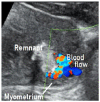Overview of Neo-Vascular Lesions after Delivery or Miscarriage
- PMID: 33807766
- PMCID: PMC7961487
- DOI: 10.3390/jcm10051084
Overview of Neo-Vascular Lesions after Delivery or Miscarriage
Abstract
The concept of intrauterine neo-vascular lesions after pregnancy, initially called placental polyps, has changed gradually. Now, based on diagnostic imaging, such lesions are defined as retained products of conception (RPOC) with vascularization. The lesions appear after delivery or miscarriage, and they are accompanied by frequent abundant vascularization in the myometrium attached to the remnant. Many of these vascular lesions have been reported to resolve spontaneously within a few months. Acquired arteriovenous malformations (AVMs) must be considered in the differential diagnosis of RPOC with vascularization. AVMs are errors of morphogenesis. The lesions start to be constructed at the time of placenta formation. These lesions do not show spontaneous regression. Although these two lesions are recognized as neo-vascular lesions, neo-vascular lesions on imaging may represent conditions other than these two lesions (e.g., peritrophoblastic flow, uterine artery pseudoaneurysm, and villous-derived malignancies). Detecting vasculature at the placenta-myometrium interface and classifying vascular diseases according to hemodynamics in the remnant would facilitate the development of specific treatments.
Keywords: arteriovenous malformations; neo-vascular lesion; placental polyps; retained products of conception.
Conflict of interest statement
The authors declare that they have no conflicts of interest.
Figures


Similar articles
-
Hypervascular retained product of conception: Characteristic magnetic resonance imaging and possible relationship to placental polyp and pseudoaneurysm.J Obstet Gynaecol Res. 2018 Jan;44(1):165-170. doi: 10.1111/jog.13481. Epub 2017 Oct 13. J Obstet Gynaecol Res. 2018. PMID: 29027718
-
Ultrasound diagnosis and management of acquired uterine enhanced myometrial vascularity/arteriovenous malformations.Am J Obstet Gynecol. 2016 Jun;214(6):731.e1-731.e10. doi: 10.1016/j.ajog.2015.12.024. Epub 2016 Feb 9. Am J Obstet Gynecol. 2016. PMID: 26873276
-
Ten-Year Piece of Retained Products of Conception: An Unusual Cause of Secondary Infertility.Cureus. 2024 Aug 20;16(8):e67337. doi: 10.7759/cureus.67337. eCollection 2024 Aug. Cureus. 2024. PMID: 39310524 Free PMC article.
-
Differential diagnosis and management of placental polyp and uterine arteriovenous malformation: Case reports and review of the literature.Womens Health (Lond). 2016 Nov;12(6):538-543. doi: 10.1177/1745505717692590. Epub 2017 Feb 10. Womens Health (Lond). 2016. PMID: 29334028 Free PMC article. Review.
-
Placental bed research: I. The placental bed: from spiral arteries remodeling to the great obstetrical syndromes.Am J Obstet Gynecol. 2019 Nov;221(5):437-456. doi: 10.1016/j.ajog.2019.05.044. Epub 2019 Jun 1. Am J Obstet Gynecol. 2019. PMID: 31163132 Review.
Cited by
-
Special Issue Recurrent Pregnancy Loss: Etiology, Diagnosis, and Therapy.J Clin Med. 2021 Oct 28;10(21):5040. doi: 10.3390/jcm10215040. J Clin Med. 2021. PMID: 34768559 Free PMC article.
-
Trans-arterial embolization for intractable primary postpartum hemorrhage caused by arterial aneurysms with arteriovenous fistulas in the lower vagina bilaterally: a case report.J Int Med Res. 2023 Jan;51(1):3000605221150137. doi: 10.1177/03000605221150137. J Int Med Res. 2023. PMID: 36694466 Free PMC article.
-
A hypervascular placental polyp after complete abortion: a case report.BMC Womens Health. 2023 Oct 10;23(1):534. doi: 10.1186/s12905-023-02672-x. BMC Womens Health. 2023. PMID: 37817177 Free PMC article.
References
-
- Baer B.F. Placental Polypus which simulated malignant disease of the uterus. Phila. Med. Times. 1884;15:175.
-
- Hagstrom H.T. Late puerperal hemorrhages due to placental polyp. Am. J. Obstet. Gynecol. 1940;39:879–881. doi: 10.1016/S0002-9378(40)91059-6. - DOI
-
- Hoberman L.K., Hawkinson J.A., Beecham C.T. Placental polyps: Report of three cases. Obstet. Gynecol. 1963;22:25–29. - PubMed
-
- Swan R.W., Woodruff J.D. Retained products of conception: Histologic viability of placental polyps. Obstet. Gynecol. 1969;34:506–514. - PubMed
Publication types
LinkOut - more resources
Full Text Sources
Other Literature Sources

